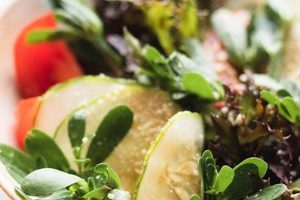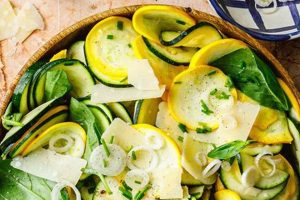This classic dish typically features a base of lettuce, followed by layers of diced tomatoes, onions, shredded cheddar cheese, crumbled bacon, peas, and mayonnaise. Variations may include ingredients such as hard-boiled eggs, black olives, green peppers, or different types of cheese and dressing. The ingredients are layered in a clear glass dish to create a visually appealing presentation.
Its popularity stems from its ease of preparation, customizable nature, and crowd-pleasing flavor profile. The layered presentation contributes to its appeal, making it a suitable dish for potlucks, picnics, and holidays. This layered salad has a history rooted in American cuisine, particularly in the mid-20th century, gaining traction as a convenient and festive dish. Its simplicity allowed for adaptations based on regional preferences and available ingredients, contributing to its enduring presence on tables across the country.
The following sections will delve into specific variations, ingredient selection guidelines, detailed preparation instructions, and tips for achieving optimal results.
Tips for a Successful Layered Salad
Achieving a visually appealing and flavorful layered salad requires attention to detail and a few key techniques. These tips offer guidance for optimal results.
Tip 1: Ingredient Preparation: Thoroughly drain ingredients like tomatoes and peas to prevent excess moisture from seeping into other layers. Dicing vegetables uniformly ensures even layering and distribution of flavors.
Tip 2: Layer Order: Place firmer, less moisture-sensitive ingredients like lettuce at the base. More delicate ingredients should be placed closer to the top. Dressing is typically placed as a final layer or served on the side.
Tip 3: Ingredient Quality: Opt for fresh, high-quality ingredients for the best flavor and texture. Crisp lettuce, ripe tomatoes, and flavorful cheese contribute significantly to the overall taste experience.
Tip 4: Visual Appeal: Arrange ingredients evenly and meticulously to create visually distinct layers. A clear glass dish best showcases the colorful layers.
Tip 5: Chilling Time: Allow the salad to chill for at least two hours before serving to allow the flavors to meld and the ingredients to settle. Avoid excessive chilling, which can wilt lettuce.
Tip 6: Scaling for Larger Groups: The recipe can be easily doubled or tripled for larger gatherings. Ensure the serving dish is large enough to accommodate the increased volume.
Tip 7: Customization: Adapt the recipe to individual preferences by substituting or adding ingredients. Explore variations with different cheeses, dressings, or vegetables.
Following these tips will ensure a flavorful, visually appealing, and enjoyable layered salad experience.
These preparations contribute to a successful outcome. The following section offers concluding thoughts.
1. Layered Construction
Layered construction is fundamental to the seven-layer salad, defining its presentation and influencing flavor perception. This technique involves arranging ingredients in distinct horizontal strata. The structural integrity of each layer contributes to the overall aesthetic appeal and prevents the dish from becoming a homogenous mixture. This separation also allows individual flavors to remain distinct while complementing adjacent layers. For example, the crispness of lettuce contrasts with the creaminess of mayonnaise, while the tanginess of tomatoes complements the savory bacon. If ingredients were simply combined, these distinct flavors and textures would be lost.
The layered approach offers practical advantages. It allows for customization based on individual preferences. Diners can selectively avoid certain ingredients, while the overall structure of the salad remains intact. Furthermore, the visual presentation enhances the dining experience. The colorful layers create an appetizing display, suitable for both casual and more formal occasions. This visual element distinguishes the seven-layer salad from other salad formats, adding to its popularity. The clear delineation of ingredients also allows for portion control and ensures a balanced intake of different components.
In summary, layered construction is integral to the seven-layer salad’s identity. It contributes to the visual appeal, preserves distinct flavors, and offers practical serving advantages. Understanding the importance of this structural element allows for successful recreation and adaptation of this classic dish. This principle extends to variations, ensuring a visually appealing and flavorful salad even with ingredient substitutions.
2. Fresh Ingredients
Ingredient freshness significantly impacts the overall quality of a seven-layer salad. The crispness of lettuce, the juiciness of tomatoes, and the sharpness of onions contribute distinct flavors and textures crucial for a successful outcome. Wilted lettuce or overripe tomatoes can compromise both the taste and the structural integrity of the layered presentation. Freshly grated cheese offers a superior flavor profile compared to pre-shredded alternatives, while recently cooked bacon provides optimal crispness. Utilizing high-quality, fresh ingredients elevates the salad from satisfactory to exceptional.
Consider the impact of using fresh versus canned peas. Fresh peas offer a sweetness and delicate texture that canned peas, often processed and stored for extended periods, cannot replicate. This difference extends to other ingredients as well. Freshly diced onions provide a pungent bite, whereas onions stored for too long can develop an off-putting flavor. The use of fresh ingredients not only enhances individual flavors but also contributes to the overall balance and harmony of the dish. A seven-layer salad composed of fresh, vibrant ingredients offers a superior sensory experience compared to one made with less-than-optimal components. Using substandard ingredients can lead to a watery, less appealing salad, diminishing the desired textural contrasts.
Prioritizing fresh ingredients ensures a flavorful and visually appealing seven-layer salad. This emphasis on quality underscores the dish’s potential to showcase the natural flavors of individual components. While substitutions may be necessary based on availability, aiming for the freshest possible ingredients significantly elevates the final product. This commitment to freshness contributes to a more enjoyable and satisfying dining experience, highlighting the inherent simplicity and deliciousness of this classic dish. Understanding the role of fresh ingredients is therefore crucial for anyone seeking to create a truly exceptional seven-layer salad.
3. Flavor Balance
Flavor balance is crucial for a successful seven-layer salad. The dish relies on a harmonious interplay of tastescreamy, tangy, salty, and freshto create a satisfying overall experience. A well-balanced seven-layer salad avoids any single flavor dominating, resulting in a cohesive and enjoyable culinary experience. Achieving this balance requires careful consideration of ingredient selection and proportions.
- Creaminess
Creaminess, typically provided by mayonnaise or a similar dressing, serves as a unifying element, binding the other ingredients and providing a rich mouthfeel. Overuse can lead to a heavy, overly rich salad, while too little can result in a dry, less cohesive dish. The creaminess should complement, not overwhelm, the other flavors.
- Tanginess
Ingredients like tomatoes and onions introduce tanginess, cutting through the richness of the creamy elements. This acidity adds brightness and complexity, preventing the salad from feeling bland. The level of tanginess should be balanced against the other flavors to avoid an overly sharp or acidic taste. For example, using overly acidic tomatoes can create an imbalance.
- Saltiness
Saltiness, often contributed by bacon or cheese, provides a savory depth. It enhances the other flavors and adds a satisfying umami element. However, excessive salt can overpower the dish, masking the other flavors and rendering the salad unpalatable. Careful portioning of salty ingredients is therefore essential.
- Freshness
Freshness, provided by ingredients like lettuce and peas, offers a crisp, clean counterpoint to the richer elements. This element contributes a refreshing quality and textural contrast. Without sufficient fresh components, the salad can feel heavy and less vibrant. Freshness balances the overall flavor profile and contributes to a more enjoyable culinary experience.
The interplay of these four flavor componentscreaminess, tanginess, saltiness, and freshnessdefines the overall balance of the seven-layer salad. Careful consideration of each element’s contribution ensures a harmonious blend of flavors, creating a dish that is both satisfying and refreshing. A well-executed balance enhances the appeal of the seven-layer salad, making it a popular choice for various occasions. Ignoring this balance can result in a less enjoyable, potentially unappetizing, experience, highlighting the importance of this fundamental culinary principle.
4. Textural Contrast
Textural contrast significantly contributes to the appeal of a seven-layer salad. The interplay of crisp, crunchy, smooth, and creamy textures creates a dynamic sensory experience. This contrast arises from the careful selection and layering of ingredients. Crisp lettuce provides a foundation, followed by potentially crunchy elements like bacon or nuts. Softer components, such as tomatoes, peas, or hard-boiled eggs, offer textural variation, while creamy layers of mayonnaise or sour cream bind the ingredients and provide a smooth counterpoint. The absence of textural contrast would result in a monotonous, less satisfying dish. Imagine a seven-layer salad composed solely of soft ingredients; it would lack the dynamic interplay that makes it so appealing. A salad consisting only of crunchy elements would similarly lack balance.
This textural diversity elevates the dining experience. Each bite offers a unique combination of textures, keeping the palate engaged. The crispness of lettuce against the creamy dressing, the crunch of bacon alongside the smoothness of hard-boiled eggthese contrasts add complexity and prevent the salad from becoming one-dimensional. This principle can be observed in other culinary contexts as well. Consider the popularity of combining crunchy croutons with creamy soup or the pairing of crispy fried chicken with smooth mashed potatoes. The appeal of textural contrast is a fundamental aspect of culinary arts.
Achieving optimal textural contrast in a seven-layer salad requires thoughtful ingredient selection and preparation. Dicing vegetables uniformly, ensuring bacon retains its crispness, and preventing the salad from becoming soggy through careful layering and drainage are crucial steps. The practical significance of this understanding lies in its ability to elevate a simple dish into a more complex and satisfying culinary experience. By focusing on textural contrast, one can transform the seven-layer salad from a basic combination of ingredients into a dynamic and memorable dish.
5. Visual Appeal
Visual appeal is a defining characteristic of the seven-layer salad, significantly contributing to its popularity and suitability for various occasions. The layered presentation, with its distinct bands of colorful ingredients, transforms a simple combination of components into a visually striking dish. This aesthetic quality enhances the dining experience, making the salad a centerpiece for gatherings and celebrations.
- Color Contrast
The vibrant colors of the ingredients create an eye-catching display. The contrast between the deep green lettuce, bright red tomatoes, stark white onions, rich orange cheddar cheese, and brown bacon generates visual interest. This colorful arrangement enhances the perceived freshness and quality of the ingredients, making the salad more appealing. Consider the difference between a salad with uniformly colored ingredients and one with a diverse color palette; the latter is inherently more visually engaging.
- Layered Arrangement
The distinct layers showcase the individual ingredients while creating a sense of order and structure. This meticulous arrangement adds to the aesthetic appeal, distinguishing the seven-layer salad from other, less visually structured salads. The layered format also allows for appreciation of the variety of ingredients, each contributing to the overall visual composition.
- Ingredient Choice
The choice of ingredients impacts not only the flavor but also the visual presentation. Using a variety of textures and shapes, such as diced tomatoes, shredded cheese, and crumbled bacon, adds visual depth and complexity. This diversity contributes to the overall aesthetic appeal, making the salad more visually engaging. Substituting ingredients can alter the visual presentation; for example, using a different type of cheese could change the color scheme.
- Serving Dish
The serving dish plays a crucial role in showcasing the visual appeal of the seven-layer salad. A clear glass dish is typically preferred, as it allows the colorful layers to be fully visible. The dish’s size and shape also contribute to the presentation. A large, shallow dish emphasizes the horizontal layering, while a deeper dish might obscure some of the lower layers. The choice of serving dish can either enhance or detract from the overall visual impact.
These elements of visual appeal contribute significantly to the overall perception and enjoyment of the seven-layer salad. The combination of color contrast, layered arrangement, ingredient choice, and serving dish transforms a simple salad into a visually captivating culinary creation. This aesthetic quality elevates the dining experience, making the seven-layer salad a popular and visually appealing choice for a wide range of occasions. Understanding these visual elements allows for careful construction and presentation of the salad, maximizing its aesthetic impact.
6. Chilling Time
Chilling time is a crucial element in a seven-layer salad recipe, influencing both flavor development and structural integrity. Refrigeration allows the individual flavors of the various componentslettuce, tomatoes, onions, cheese, bacon, and dressingto meld, creating a more cohesive and complex flavor profile. The cool temperature also firms the vegetables, enhancing their crispness and contributing to the structural integrity of the layered presentation. Without sufficient chilling, the flavors remain distinct, and the salad may lack the desired depth of flavor. Furthermore, warmer temperatures can accelerate the wilting of lettuce and other vegetables, compromising the visual appeal and textural integrity of the layered structure.
Consider the difference between a freshly assembled seven-layer salad and one that has been chilled for several hours. The freshly made salad, while containing all the same ingredients, lacks the integrated flavor profile of its chilled counterpart. The individual flavors of the components are more pronounced, and the overall taste experience is less harmonious. The chilled salad, on the other hand, benefits from the melding of flavors, resulting in a more balanced and nuanced taste. The chilled temperature also enhances the crispness of the vegetables, providing a more satisfying textural experience. Insufficient chilling can also lead to a watery salad as the ingredients release moisture at room temperature.
Understanding the importance of chilling time allows for optimal preparation and enjoyment of a seven-layer salad. A minimum chilling time of two hours is generally recommended, although longer periods, up to 24 hours, can further enhance flavor development, provided the salad is properly sealed to prevent moisture loss and absorption of odors from other refrigerated items. This knowledge has practical implications for preparing the salad in advance of serving, facilitating time management for gatherings and events. Proper chilling ensures that the seven-layer salad delivers its signature combination of balanced flavors, crisp textures, and visual appeal, highlighting the crucial role of temperature in optimizing this classic dish.
7. Adaptability
Adaptability is a key feature of the seven-layer salad, allowing for customization based on individual preferences, dietary restrictions, and ingredient availability. This inherent flexibility contributes to the recipe’s enduring popularity and suitability for diverse occasions. Modifications can range from simple ingredient substitutions to more substantial alterations, impacting flavor profiles, textures, and overall presentation. For example, substituting black beans for ground beef caters to vegetarian preferences, while swapping French dressing for mayonnaise offers a lighter, tangier flavor profile. Using different types of cheese, such as pepper jack or Monterey Jack, introduces nuanced flavor variations, while incorporating alternative vegetables like bell peppers or corn expands the nutritional profile and adds visual interest. The adaptability extends to ingredient quantities as well; adjusting the proportions of individual components allows for customization based on desired flavor intensity and overall portion size. Adaptability offers practical solutions for accommodating dietary restrictions without sacrificing the essential characteristics of the dish. Gluten-free versions can be achieved by selecting gluten-free crackers or omitting them altogether. Dairy-free adaptations are possible through the use of vegan mayonnaise and cheese alternatives.
This inherent adaptability fosters culinary creativity and personalization. Individuals can experiment with various ingredients, dressings, and toppings to create unique flavor combinations and presentations tailored to specific tastes. For instance, incorporating roasted vegetables like sweet potatoes or zucchini adds a smoky, caramelized element, while the addition of nuts or seeds introduces textural complexity and nutritional value. The adaptability of the seven-layer salad also makes it an ideal dish for utilizing seasonal produce. Substituting fresh, locally sourced ingredients not only enhances flavor but also supports sustainable practices. This flexibility extends to accommodating ingredient availability; substitutions based on what is readily available in one’s pantry or refrigerator allow for spontaneous meal preparation without compromising flavor or presentation. This practical aspect further contributes to the recipe’s widespread appeal.
The adaptability of the seven-layer salad underscores its versatility as a culinary creation. This flexibility extends beyond individual preferences and dietary needs, reflecting broader cultural and regional variations. The core concept of layered ingredients allows for adaptations incorporating regional specialties and culinary traditions. The seven-layer salad becomes a canvas for culinary expression, reflecting the diverse tastes and preferences of individuals and communities. Understanding this adaptability allows for both appreciation and creative exploration of this classic dish, ensuring its continued relevance and enjoyment across diverse culinary landscapes.
Frequently Asked Questions
This section addresses common inquiries regarding the seven-layer salad, offering practical guidance and clarifying potential misconceptions.
Question 1: Can the salad be prepared the day before serving?
Preparing the salad a day in advance is generally acceptable, allowing flavors to meld. However, certain ingredients, like lettuce, may become less crisp. Adding lettuce immediately before serving is recommended for optimal texture.
Question 2: What are suitable substitutions for mayonnaise?
Alternatives to mayonnaise include sour cream, Greek yogurt, or a combination for a tangier flavor profile. Dairy-free options include vegan mayonnaise or avocado-based dressings.
Question 3: How can excess moisture be prevented?
Thoroughly draining moisture-rich ingredients, such as tomatoes and peas, is essential. Salting tomatoes and allowing them to drain can further reduce moisture content.
Question 4: Can different types of cheese be used?
Variations in cheese are encouraged. Cheddar, Colby, Monterey Jack, or a blend offer diverse flavor profiles. Consider flavor intensity when selecting cheese.
Question 5: What are suitable additions or substitutions for bacon?
Alternatives to bacon include diced ham, chopped cooked chicken, or chickpeas for a vegetarian option. These substitutions offer varied textures and flavors.
Question 6: How long can the salad be stored in the refrigerator?
Properly sealed, the salad can be refrigerated for up to three days. However, optimal quality is maintained within the first 24 hours.
These responses provide practical guidance for achieving optimal results. Careful preparation ensures a successful and enjoyable culinary experience.
The following section offers a collection of recipe variations for further exploration.
Seven Layer Salad Recipe
This exploration of the seven-layer salad recipe has highlighted the key elements contributing to its enduring appeal: layered construction, fresh ingredients, flavor balance, textural contrast, visual appeal, chilling time, and adaptability. Each component plays a crucial role in the final product, influencing taste, texture, and presentation. Understanding these elements allows for successful preparation and customization, catering to individual preferences and dietary needs. The layered approach not only creates a visually striking dish but also preserves the distinct flavors of individual ingredients. Emphasis on fresh, high-quality ingredients maximizes flavor and textural complexity. Balancing creamy, tangy, salty, and fresh flavors ensures a harmonious taste experience. The interplay of crisp, crunchy, smooth, and creamy textures provides a dynamic sensory experience. Visual appeal, enhanced by color contrast and layered arrangement, makes this salad a centerpiece for various occasions. Proper chilling allows flavors to meld and enhances textural integrity. Finally, adaptability enables customization based on individual preferences and ingredient availability, demonstrating the recipe’s versatility.
The seven-layer salad, while simple in concept, offers a complex interplay of flavors, textures, and visual elements. Its enduring popularity speaks to its adaptability and capacity to satisfy diverse palates. Continued exploration of variations and ingredient combinations ensures this classic dish remains a vibrant and evolving culinary tradition. Careful attention to the outlined principles guarantees a successful outcome, transforming a simple recipe into a memorable culinary experience.






